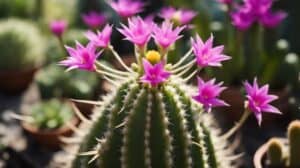The Fishbone Cactus, also known as Epiphyllum anguliger, is a unique and intriguing plant that is gaining popularity amongst plant enthusiasts. Its zigzag-shaped stems resemble fishbones, hence its name. This cactus is native to Central and South America, where it grows as an epiphyte on trees in the jungle.

Propagating the Fishbone Cactus can be a fun and rewarding experience for plant lovers. One popular method is through stem cuttings. The process involves taking a healthy stem cutting, allowing it to callus over, and then planting it in well-draining soil. With proper care, the cutting will eventually develop roots and grow into a new plant. Another method is through seed propagation, which can be a bit more challenging but equally rewarding. It involves collecting mature seeds and planting them in a suitable growing medium.
Jungle Zigzag: Propagating Fishbone Cactus (Epiphyllum anguliger) explores the different methods of propagating this unique cactus and provides tips for successful growth and care. Whether you’re a seasoned plant enthusiast or just starting out, this article will provide valuable information on how to propagate and care for this fascinating plant.
Understanding Fishbone Cactus
Species Overview
Fishbone cactus (Epiphyllum anguliger) is a species of epiphytic cactus native to Central and South America. It is a member of the Cactaceae family, which includes over 2,000 species of cacti. Fishbone cactus is also commonly known as zigzag cactus, due to the distinctive zigzag shape of its stems.
Fishbone cactus is a popular houseplant due to its unique appearance and ease of care. It is a fast-growing plant that can reach up to 3 feet in length. The stems of fishbone cactus are flat and leaf-like, with deep, V-shaped notches that give them their characteristic zigzag shape.
Natural Habitat
Fishbone cactus is native to the tropical rainforests of Central and South America, where it grows as an epiphyte. Epiphytes are plants that grow on other plants, such as trees, without harming them. In the wild, fishbone cactus grows on the branches of trees, using its aerial roots to absorb nutrients and moisture from the air.
The natural habitat of fishbone cactus is warm and humid, with temperatures ranging from 60 to 85 degrees Fahrenheit and high levels of rainfall. These conditions can be difficult to replicate indoors, but fishbone cactus is a hardy plant that can adapt to a wide range of growing conditions. With proper care, it can thrive in a variety of environments, making it a popular choice for indoor gardening.
Propagation Basics

Propagation Methods
Propagating Fishbone Cactus can be done through various methods, including stem cuttings and seeds. Stem cuttings are the most common and easiest method of propagation. To propagate through stem cuttings, one should take a healthy stem cutting that is at least 6 inches long and has no signs of disease or damage. The cutting should be allowed to dry for a few days before planting it in a well-draining soil mix.
Seeds can also be used for propagation, but they require more effort and patience. The seeds should be sown in a well-draining soil mix and kept moist until they germinate. It may take several months for the seeds to germinate, and the resulting plants may not be identical to the parent plant.
Optimal Conditions for Propagation
To ensure successful propagation, it is important to provide optimal conditions for the newly planted cuttings or seeds. The following are some guidelines for providing optimal conditions:
-
Light: Fishbone Cactus prefers bright, indirect light. Placing the newly planted cuttings or seeds in a location with bright, indirect light will help them grow healthy and strong.
-
Temperature: Fishbone Cactus prefers warm temperatures between 60-80°F. It is important to keep the newly planted cuttings or seeds in a warm location to encourage growth.
-
Humidity: Fishbone Cactus prefers high humidity levels. To provide optimal conditions, one can cover the newly planted cuttings or seeds with a plastic bag or dome to increase humidity levels.
-
Soil: Fishbone Cactus prefers well-draining soil. It is important to use a well-draining soil mix to prevent waterlogging, which can lead to root rot.
By following these guidelines, one can ensure successful propagation of Fishbone Cactus and enjoy its unique beauty in their home or garden.
Plant Care After Propagation

After successfully propagating a fishbone cactus, it is important to give it proper care to ensure its growth and health. The following subsections will provide information on the watering requirements, light and temperature needs, and fertilization and pruning of the plant.
Watering Requirements
Fishbone cactus prefers well-draining soil that is moist but not waterlogged. It is important not to overwater the plant as it can lead to root rot. The frequency of watering depends on the temperature and humidity of the environment. During the growing season, water the plant when the top inch of soil is dry to the touch. In the winter, reduce watering to once a month to allow the plant to go dormant.
Light and Temperature
Fishbone cactus prefers bright, indirect light. Direct sunlight can damage the leaves and cause sunburn. The ideal temperature range for the plant is between 60-80°F (15-27°C). Avoid exposing the plant to temperatures below 50°F (10°C) as it can cause damage to the plant.
Fertilization and Pruning
Fertilize the fishbone cactus once a month during the growing season with a balanced fertilizer. Avoid fertilizing during the winter when the plant is dormant. Pruning is not necessary for the plant but can be done to control its size and shape. Prune the plant in the spring before the growing season begins.
By following these care instructions, the propagated fishbone cactus will thrive and add beauty to any indoor or outdoor space.
Frequently Asked Questions

What is the best method to propagate a Fishbone Cactus?
The best method to propagate a Fishbone Cactus is by taking stem cuttings. It is recommended to take a cutting that is at least 6 inches long and has a few segments. Make sure to let the cutting callous over for a few days before planting it in well-draining soil.
Can you propagate Fishbone Cactus in water, and if so, how?
Yes, Fishbone Cactus can be propagated in water. Simply take a stem cutting and place it in a jar filled with water. Change the water every few days to prevent bacteria growth. Once roots have formed, plant the cutting in well-draining soil.
What are the signs of successful Fishbone Cactus propagation?
Signs of successful Fishbone Cactus propagation include the appearance of new growth, roots that have formed and have started to grow, and the cutting remaining firm and not rotting.
How long does it take for a Fishbone Cactus cutting to root?
It can take anywhere from 2-6 weeks for a Fishbone Cactus cutting to root. This can vary depending on the environment and growing conditions.
What should I do if my Fishbone Cactus cutting develops aerial roots?
If your Fishbone Cactus cutting develops aerial roots, it is a good sign that the cutting is healthy and growing. You can either leave the aerial roots as they are or plant the cutting in soil to encourage further growth.
Are there common problems to look out for when propagating Fishbone Cactus?
Common problems when propagating Fishbone Cactus include overwatering, which can cause the cutting to rot, and under-watering, which can cause the cutting to dry out. It is important to strike a balance and provide the cutting with enough water and light to encourage growth.













